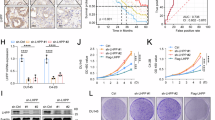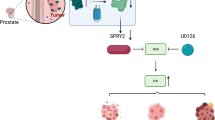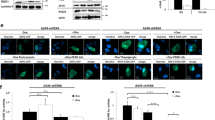Abstract
Cancer cells frequently evade apoptosis during tumorigenesis by acquiring mutations in apoptotic regulators. Chronic activation of the PI 3-kinase-Akt pathway through loss of the tumor suppressor PTEN is one mechanism by which these cells can gain increased protection against apoptosis. We report here that REDD1 (RTP801) can act as a transcriptional downstream target of PI 3-kinase signaling in human prostate cancer cells (PC-3). REDD1 expression is markedly reduced in PC-3 cells treated with LY294002 (LY) or Rapamycin and strongly induced under hypoxic conditions in a hypoxia-inducible factor-1 (HIF-1)-dependent manner. Loss of function studies employing antisense molecules or RNA interference indicate that REDD1 is essential for invasive growth of prostate cancer cells in vitro and in vivo. Reduced REDD1 levels can sensitize cells towards apoptosis, whereas elevated levels of REDD1 induced by hypoxia or overexpression desensitize cells to apoptotic stimuli. Taken together our data designate REDD1 as a novel target for therapeutic intervention in prostate cancer.
This is a preview of subscription content, access via your institution
Access options
Subscribe to this journal
Receive 50 print issues and online access
$259.00 per year
only $5.18 per issue
Buy this article
- Purchase on SpringerLink
- Instant access to full article PDF
Prices may be subject to local taxes which are calculated during checkout






Similar content being viewed by others
References
Adler V, Yin Z, Tew KD and Ronai Z . (1999). Oncogene, 18, 6104–6111.
Akakura N, Kobayashi M, Horiuchi I, Suzuki A, Wang J, Chen J, Niizeki H, Kawamura K, Hosokawa M and Asaka M . (2001). Cancer Res., 61, 6548–6554.
Alvarez-Tejado M, Alfranca A, Aragones J, Vara A, Landazuri MO and del Peso L . (2002). J. Biol. Chem., 277, 13508–13517.
Anastasiadis AG, Bemis DL, Stisser BC, Salomon L, Ghafar MA and Buttyan R . (2003). Curr. Drug Targets, 4, 191–196.
Arsham AM, Plas DR, Thompson CB and Simon MC . (2002). J. Biol. Chem., 277, 15162–15170.
Arsham AM, Plas DR, Thompson CB and Simon MC . (2004). Cancer Res., 64, 3500–3507.
Baek JH, Jang JE, Kang CM, Chung HY, Kim ND and Kim KW . (2000). Oncogene, 19, 4621–4631.
Bardos JI, Chau NM and Ashcroft M . (2004). Mol. Cell. Biol., 24, 2905–2914.
Blouw B, Song H, Tihan T, Bosze J, Ferrara N, Gerber HP, Johnson RS and Bergers G . (2003). Cancer Cell, 4, 133–146.
Bottaro DP and Liotta LA . (2003). Nature, 423, 593–595.
Boukamp P, Petrussevska RT, Breitkreutz D, Hornung J, Markham A and Fusenig NE . (1988). J. Cell Biol., 106, 761–771.
Cantley LC and Neel BG . (1999). Proc. Natl. Acad. Sci. USA, 96, 4240–4245.
Carmeliet P, Dor Y, Herbert JM, Fukumura D, Brusselmans K, Dewerchin M, Neeman M, Bono F, Abramovitch R, Maxwell P, Koch CJ, Ratcliffe P, Moons L, Jain RK, Collen D, Keshert E and Keshet E . (1998). Nature, 394, 485–490.
Chrastina A . (2003). Neoplasma, 50, 251–256.
Chun YS, Choi E, Kim GT, Choi H, Kim CH, Lee MJ, Kim MS and Park JW . (2000). Eur. J. Biochem., 267, 4198–4204.
Coffer PJ, Jin J and Woodgett JR . (1998). Biochem. J., 335 (Part 1), 1–13.
Czauderna F, Fechtner M, Aygun H, Arnold W, Klippel A, Giese K and Kaufmann J . (2003a). Nucleic Acids Res., 31, 670–682.
Czauderna F, Santel A, Hinz M, Fechtner M, Durieux B, Fisch G, Leenders F, Arnold W, Giese K, Klippel A and Kaufmann J . (2003b). Nucleic Acids Res., 31, e127.
Di Cristofano A and Pandolfi PP . (2000). Cell, 100, 387–390.
Ellisen LW, Ramsayer KD, Johannessen CM, Yang A, Beppu H, Minda K, Oliner JD, McKeon F and Haber DA . (2002). Mol. Cell, 10, 995–1005.
Finkel T . (2000). FEBS Lett., 476, 52–54.
Ghafar MA, Anastasiadis AG, Chen MW, Burchardt M, Olsson LE, Xie H, Benson MC and Buttyan R . (2003). Prostate, 54, 58–67.
Hanahan D and Weinberg RA . (2000). Cell, 100, 57–70.
Harris AL . (2002). Nat. Rev. Cancer, 2, 38–47.
Hockel M and Vaupel P . (2001). Semin. Oncol., 28, 36–41.
Hudson CC, Liu M, Chiang GG, Otterness DM, Loomis DC, Kaper F, Giaccia AJ and Abraham RT . (2002). Mol. Cell. Biol., 22, 7004–7014.
Ivan M, Kondo K, Yang H, Kim W, Valiando J, Ohh M, Salic A, Asara JM, Lane WS and Kaelin Jr WG . (2001). Science, 292, 464–468.
Jiang BH, Jiang G, Zheng JZ, Lu Z, Hunter T and Vogt PK . (2001). Cell Growth Differ., 12, 363–369.
Kaufmann J, Pronk G, Giese K and Klippel A . (2004). Biochem. Soc. Trans., 32, 355–359.
Klippel A, Escobedo MA, Wachowicz MS, Apell G, Brown TW, Giedlin MA, Kavanaugh WM and Williams LT . (1998). Mol. Cell Biol., 18, 5699–5711.
Klippel A, Reinhard C, Kavanaugh WM, Apell G, Escobedo MA and Williams LT . (1996). Mol. Cell. Biol., 16, 4117–4127.
Kretschmer A, Moepert K, Dames S, Sternberger M, Kaufmann J and Klippel A . (2003). Oncogene, 22, 6748–6763.
Kulik G, Klippel A and Weber MJ . (1997). Mol. Cell. Biol., 17, 1595–1606.
Leenders F, Mopert K, Schmiedeknecht A, Santel A, Czauderna F, Aleku M, Penschuck S, Dames S, Sternberger M, Rohl T, Wellmann A, Arnold W, Giese K, Kaufmann J and Klippel A . (2004). EMBO J., 23, 3303–3313.
Mudgil AV, Segal N, Andriani F, Wang Y, Fusenig NE and Garlick JA . (2003). J. Invest. Dermatol., 121, 191–197.
Paul SA, Simons JW and Mabjeesh NJ . (2004). J. Cell Physiol., 200, 20–30.
Piret JP, Lecocq C, Toffoli S, Ninane N, Raes M and Michiels C . (2004). Exp. Cell Res., 295, 340–349.
Piret JP, Mottet D, Raes M and Michiels C . (2002a). Ann. N Y Acad. Sci., 973, 443–447.
Piret JP, Mottet D, Raes M and Michiels C . (2002b). Biochem. Pharmacol., 64, 889–892.
Poellinger L and Johnson RS . (2004). Curr. Opin. Genet. Dev., 14, 81–85.
Salnikow K, Su W, Blagosklonny MV and Costa M . (2000). Cancer Res., 60, 3375–3378.
Schmeichel KL and Bissell MJ . (2003). J. Cell. Sci., 116, 2377–2388.
Semenza G . (2002). Biochem. Pharmacol., 64, 993–998.
Semenza GL . (2003). Nat. Rev. Cancer, 3, 721–732.
Sheta EA, Trout H, Gildea JJ, Harding MA and Theodorescu D . (2001). Oncogene, 20, 7624–7634.
Shoshani T, Faerman A, Mett I, Zelin E, Tenne T, Gorodin S, Moshel Y, Elbaz S, Budanov A, Chajut A, Kalinski H, Kamer I, Rozen A, Mor O, Keshet E, Leshkowitz D, Einat P, Skaliter R and Feinstein E . (2002). Mol. Cell. Biol., 22, 2283–2293.
Simpson L and Parsons R . (2001). Exp. Cell Res., 264, 29–41.
Soldani C and Scovassi AI . (2002). Apoptosis, 7, 321–328.
Stephenson RA, Dinney CP, Gohji K, Ordonez NG, Killion JJ and Fidler IJ . (1992). J. Natl. Cancer Inst., 84, 951–957.
Sternberger M, Schmiedeknecht A, Kretschmer A, Gebhardt F, Leenders F, Czauderna F, Von Carlowitz I, Engle M, Giese K, Beigelman L and Klippel A . (2002). Antisense Nucleic Acid Drug Dev., 12, 131–143.
Tondera D, Santel A, Schwarzer R, Dames S, Giese K, Klippel A and Kaufmann J . (2004). J. Biol. Chem., 279, 31544–31555.
Vanhaesebroeck B and Waterfield MD . (1999). Exp. Cell Res., 253, 239–254.
Vazquez F and Sellers WR . (2000). Biochim. Biophys. Acta, 1470, M21–M35.
Yim S, Choi SM, Choi Y, Lee N, Chung J and Park H . (2003). J. Biol. Chem., 278, 38260–38268.
Zaman K, Ryu H, Hall D, O'Donovan K, Lin KI, Miller MP, Marquis JC, Baraban JM, Semenza GL and Ratan RR . (1999). J. Neurosci., 19, 9821–9830.
Zhang SX, Gozal D, Sachleben Jr LR, Rane M, Klein JB and Gozal E . (2003). FASEB J., 17, 1709–1711.
Zhong H, De Marzo AM, Laughner E, Lim M, Hilton DA, Zagzag D, Buechler P, Isaacs WB, Semenza GL and Simons JW . (1999). Cancer Res., 59, 5830–5835.
Zhou J, Schmid T, Frank R and Brune B . (2004). J. Biol. Chem., 279, 13506–13513.
Acknowledgements
We thank Petra Boukamp for providing the HaCaT keratinocyte cell line and Axel Wellmann for providing human prostate tumor tissue samples. We are grateful to Oliver Keil and Jens Endruschat for preparing transfection vehicles and to Silke Penschuck for immunohistochemical stainings of tumor sections. We thank Maria Sternberger for recombinant protein expression and purification, Anny Kretschmer for isolating a p63-specific GB and a mismatch control antisense molecule, Katharina Paulick for help with preparation of shRNA expression plasmids and Ralf Sägebarth and Steve Lack for expert bioinformatic support. This study was supported by a grant from the Bundesministerium für Wirtschaft und Technologie (No. 1078/02).
Author information
Authors and Affiliations
Corresponding author
Rights and permissions
About this article
Cite this article
Schwarzer, R., Tondera, D., Arnold, W. et al. REDD1 integrates hypoxia-mediated survival signaling downstream of phosphatidylinositol 3-kinase. Oncogene 24, 1138–1149 (2005). https://doi.org/10.1038/sj.onc.1208236
Received:
Revised:
Accepted:
Published:
Issue Date:
DOI: https://doi.org/10.1038/sj.onc.1208236
Keywords
This article is cited by
-
Nuclear overexpression of DNA damage-inducible transcript 4 (DDIT4) is associated with aggressive tumor behavior in patients with pancreatic tumors
Scientific Reports (2023)
-
The m6A demethylase ALKBH5-mediated upregulation of DDIT4-AS1 maintains pancreatic cancer stemness and suppresses chemosensitivity by activating the mTOR pathway
Molecular Cancer (2022)
-
Exploring the molecular interface between hypoxia-inducible factor signalling and mitochondria
Cellular and Molecular Life Sciences (2019)
-
miR-429 regulates the transition between Hypoxia-Inducible Factor (HIF)1A and HIF3A expression in human endothelial cells
Scientific Reports (2016)
-
Quinolinic acid induces cell apoptosis in PC12 cells through HIF-1-dependent RTP801 activation
Metabolic Brain Disease (2016)



